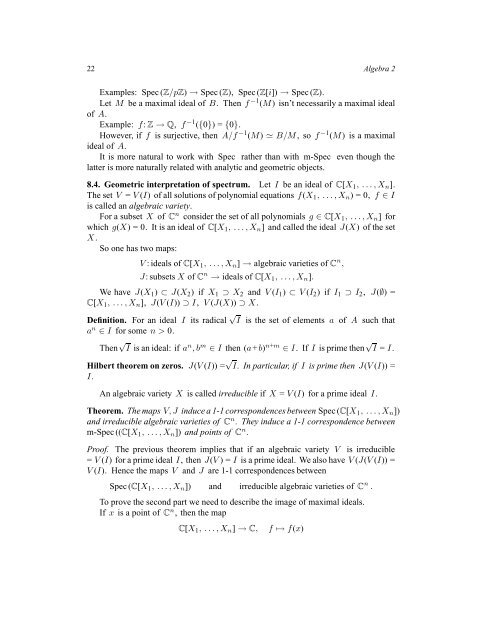Algebra (Unknown 27). - Index of
Algebra (Unknown 27). - Index of
Algebra (Unknown 27). - Index of
You also want an ePaper? Increase the reach of your titles
YUMPU automatically turns print PDFs into web optimized ePapers that Google loves.
22 <strong>Algebra</strong> 2<br />
Examples: Spec (Z/pZ) → Spec (Z), Spec (Z[i]) → Spec (Z).<br />
Let M be a maximal ideal <strong>of</strong> B. Then f −1 (M) isn’t necessarily a maximal ideal<br />
<strong>of</strong> A.<br />
Example: f: Z → Q, f −1 ({0}) = {0}.<br />
However, if f is surjective, then A/f −1 (M) ≃ B/M , so f −1 (M) is a maximal<br />
ideal <strong>of</strong> A.<br />
It is more natural to work with Spec rather than with m-Spec even though the<br />
latter is more naturally related with analytic and geometric objects.<br />
8.4. Geometric interpretation <strong>of</strong> spectrum. Let I be an ideal <strong>of</strong> C[X 1 , . . . , X n ].<br />
The set V = V (I) <strong>of</strong> all solutions <strong>of</strong> polynomial equations f(X 1 , . . . , X n ) = 0, f ∈ I<br />
is called an algebraic variety.<br />
For a subset X <strong>of</strong> C n consider the set <strong>of</strong> all polynomials g ∈ C[X 1 , . . . , X n ] for<br />
which g(X) = 0. It is an ideal <strong>of</strong> C[X 1 , . . . , X n ] and called the ideal J(X) <strong>of</strong> the set<br />
X.<br />
So one has two maps:<br />
V : ideals <strong>of</strong> C[X 1 , . . . , X n ] → algebraic varieties <strong>of</strong> C n ,<br />
J: subsets X <strong>of</strong> C n → ideals <strong>of</strong> C[X 1 , . . . , X n ].<br />
We have J(X 1 ) ⊂ J(X 2 ) if X 1 ⊃ X 2 and V (I 1 ) ⊂ V (I 2 ) if I 1 ⊃ I 2 , J(∅) =<br />
C[X 1 , . . . , X n ], J(V (I)) ⊃ I, V (J(X)) ⊃ X.<br />
Definition. For an ideal I its radical √ I is the set <strong>of</strong> elements a <strong>of</strong> A such that<br />
a n ∈ I for some n > 0.<br />
Then √ I is an ideal: if a n , b m ∈ I then (a+b) n+m ∈ I. If I is prime then √ I = I.<br />
Hilbert theorem on zeros. J(V (I)) = √ I. In particular, if I is prime then J(V (I)) =<br />
I.<br />
An algebraic variety X is called irreducible if X = V (I) for a prime ideal I.<br />
Theorem. The maps V, J induce a 1-1 correspondences between Spec (C[X 1 , . . . , X n ])<br />
and irreducible algebraic varieties <strong>of</strong> C n . They induce a 1-1 correspondence between<br />
m-Spec ((C[X 1 , . . . , X n ]) and points <strong>of</strong> C n .<br />
Pro<strong>of</strong>. The previous theorem implies that if an algebraic variety V is irreducible<br />
= V (I) for a prime ideal I, then J(V ) = I is a prime ideal. We also have V (J(V (I)) =<br />
V (I). Hence the maps V and J are 1-1 correspondences between<br />
Spec (C[X 1 , . . . , X n ]) and irreducible algebraic varieties <strong>of</strong> C n .<br />
To prove the second part we need to describe the image <strong>of</strong> maximal ideals.<br />
If x is a point <strong>of</strong> C n , then the map<br />
C[X 1 , . . . , X n ] → C,<br />
f ↦→ f(x)

















